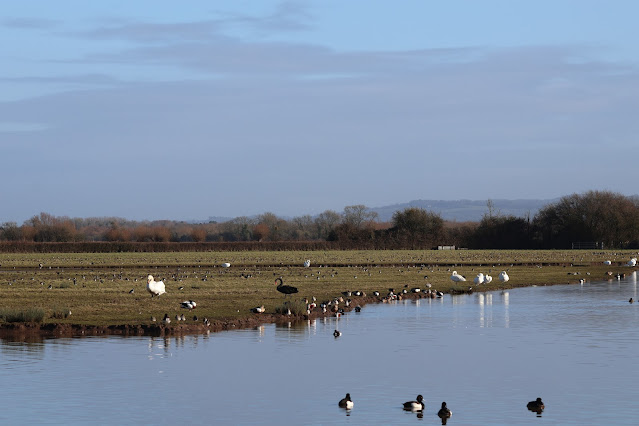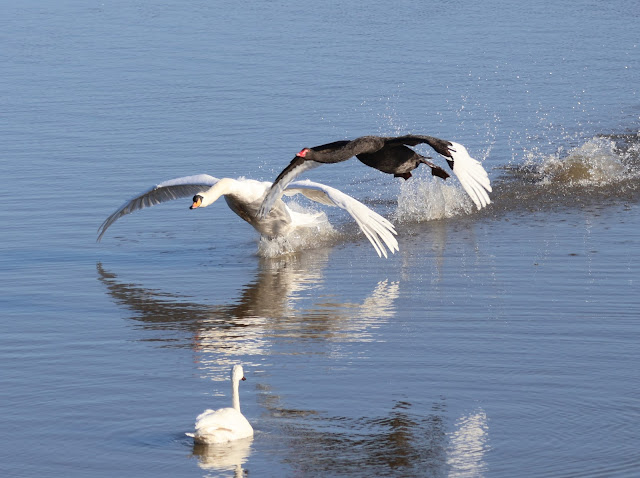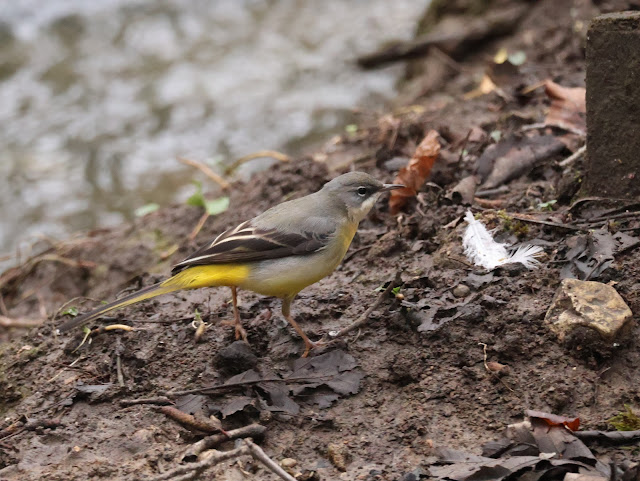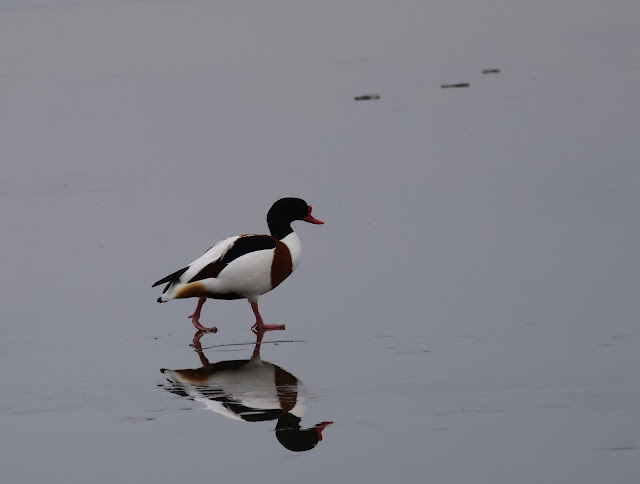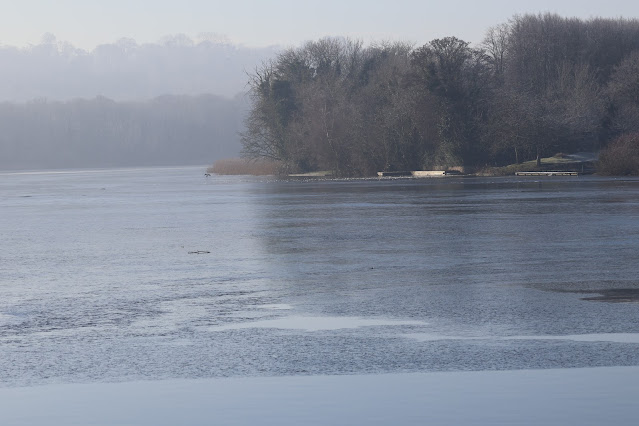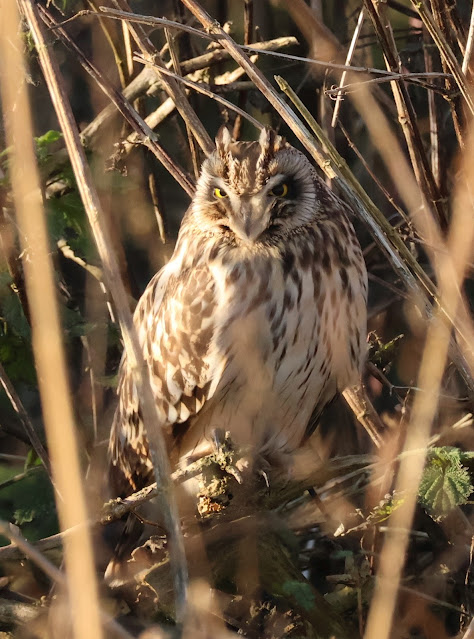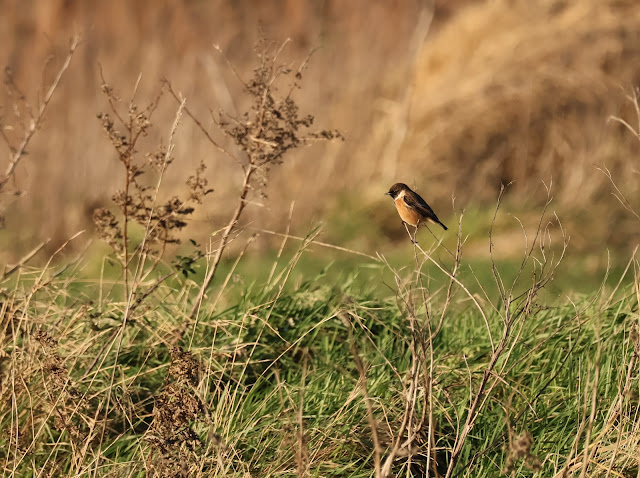Friday, 31 January 2025
A GLOSSY IBIS AND OTHER BIRDS
Monday, 27 January 2025
BIG GARDEN BIRDWATCH 2025
Nothing unusual in today's Big Garden Birdwatch ( which I did a day late) but my results reflected my usual counts. It was sunny but quite windy, nevertheless the birds were very active on and around my feeders for the entire hour I spent recording. I've had up to 3 blackcaps (2m 2f) regularly since Mid-November though usually singly and today it was the male's turn. No crows or magpies showed up, possibly due to a lack of scraps on offer. There was, however, still a choice of fatballs, seed mix and sunflower hearts.
Results were as follows:
Blue tit 3
Great tit 2
Robin 1
Blackbird 1f
Wood pigeon 4
House sparrow 8
Dunnock 2
Blackcap 1m
Chaffinch 1f
Goldfinch 2
10 species 25 birds
Tuesday, 21 January 2025
DIPPER AT FROME BANKS
Today I drove straight from work to visit a nature reserve in Stroud which is accessed from a road below the Waitrose carpark. This is the most reliable place I know locally where one can see a dipper and is somewhere I visit each year around this time.
After parking in the pay and display car park I made my way past Waitrose and down some steps to cross the road into the reserve. You then have to follow a path which takes you back to the main road, over a canal bridge then back down another path along the canal to reach the start of the reserve. From here a rather muddy path leads alongside the river Frome for about half a mile where it ends. If you look carefully there is a very good chance of seeing a dipper, and possibly a grey wagtail too.
As I walked along the riverbank, I soon saw a grey wagtail searching for insects amongst the vegetation and tree roots, it flitted back and forth across the river before flying downstream. The grey and lemon colours and long tail make this one of my favourite birds.
I saw a man coming towards me and when I enquired if he had seen a dipper, he informed me that there were a pair of dippers further along near a site where some workmen were reconstructing a boardwalk.
I soon came across signs of construction, although it appeared that the workmen were still on their lunch break as they were no where to be seen. I scanned the banks and almost straightaway spotted a dipper bobbing up and down on a branch/root sticking out from the bank opposite. The bird's dark body blended in with the dark coloured mud of the riverbank but its white bib gave its presence away. l watched it as it occasionally dipped its beak into the water, or stood or swam on the surface and sometimes below the surface. After a short time it flew back in the direction I had come from.
The good thing about this reserve is that much of the river can be seen from the path, although sometimes partially obscured by tall grasses or brambles or some small trees. This gives quite a bit of cover but at the same time good visibility when looking for the dipper. Therefore I soon re-found the bird, still on the opposite bank, perching alternately on small stones, pieces of branches etc. in between its foraging in the water
The river is shaded by tall trees and vegetation both sides so it can feel quite dark, especially on an overcast day, and as it seemed as if it might rain, I decided to return to the car park after a successful visit.
Monday, 20 January 2025
JANUARY VISITS TO SLIMBRIDGE
A visit to Slimbridge WWT centre today with some friends produced a respectable 46 species, including 4 swan species on the Rushy, nine duck species, and 4 geese species ( we missed the white-fronts). Our first stop was the hide overlooking the Rushy Pen where we saw and heard many Bewick swans. A pair of Whooper swans was also present, together with a mute and a black swan. When I visited earlier in the week the area known as the Tack Piece was frozen and more or less devoid of birds, so it was good to see birds present in huge numbers after the thaw, including lapwing, golden plover, dunlin, redshank and curlew. We also saw a little egret flying and a snipe flew out from the reeds just in front of one of the hides. There were plenty of ducks - my attention was drawn to a mallard which after preening, did a somersault underwater, waving its orange webbed feet above the surface before righting itself and giving a wing flap. It did this several times - I'm not sure if this is the usual pattern! Sadly, there was no water rail under the feeders in the usual place, but on Monday I had seen two behind one of the pools on the South Finger walkway.
From the top of the estuary tower, today, we saw Canada geese, greylags, barnacle geese and a single white Ross's goose. A party of 4 cranes ( 2 adults, 2 juveniles) also flew past and landed on the Tack piece. On our way back we noticed movement in the bushes low down beside the path and were a little surprised to see a song thrush, searching for food, seemingly not bothered by our presence as we stopped to watch.
The spoonbill was asleep as usual on one of the islands on South lake, where we also encountered a great crested grebe, cormorants, ruff and avocets, none of which showed much activity in the cold grey weather.
We decided not to go further as time was getting on, but when I popped into the Kingfisher hide last Monday the bird feeders there, were attracting a number of smaller birds including robin, chaffinches, a coal tit, blue and great tits. A pair of gadwall and a little grebe were on the pool in front of the hide .
It had been a productive day and we had all added to our year lists.
Saturday, 11 January 2025
COATE WATER ON ANOTHER COLD DAY
Today it was -4 degrees when I left home to visit Coate Water, a country park just outside Swindon. The lake was pretty much frozen, with swans and ducks congregating at the edges and flocks of gulls standing on the ice in the centre. I noted a lesser black- blacked gull, Canada geese and tufted duck which were new for the year. I took a circuit of the lake, stopping to spend some time photographing birds at the feeding station in the woods. As at Stanton Park, earlier in the week, a jay was soon attracted by the peanuts I placed on a log; it would seem it was more used to human presence as it came straight down rather than waiting up in the trees. Up in the top of the trees I heard and saw a couple of parakeets, now apparently resident at Coate Water.
As I returned towards the car park, I saw a goldcrest in one of the firs, and at the edge of the lake, a grey wagtail flew in and made its way methodically along ahead of me.
Thursday, 9 January 2025
A COLD DAY AT STANTON PARK WOODLAND
With temperatures hovering just above 0 degrees and a light covering of snow, I decided to spend a couple of hours at Stanton park where a number of woodland species of birds can be often found. It was a sunny afternoon, and after carefully crossing the icy carpark, I headed for one of the seating areas where a bird table will often attracts small birds. I tipped out some peanuts and seeds on the top and placed a snow covered log nearby, hoping that the birds would use this as a perch.
The seats were still snow covered so I went behind them and stood against a tree, hoping that would help disguise me, particularly as I rather hoped a jay would come and feed on the peanuts. With the trees bare of leaves, it was fairly easy to notice if a jay was about and it wasn't long before I saw a shape the familiar pinks, blues and whites fly into a tree some distance away, but from where I could see that it was eying up the bird table. I remained still, waiting for the jay to descend, which it did, slowly, at intervals getting nearer and nearer, until it was close enough to fly to the ground and snatch a peanut which it flew off with. It then reappeared later and spent a few seconds at the bird table, before flying off at the approach of some people with a dog.
Other species present included blue tits, robins, dunnocks, blackbird, and coal tits and the usual few squirrels.
I was also hoping to see a marsh tit and nuthatch but without seeing either here, I re-located to another feeding table which had a long log next to it, after placing more food there, I stood back amongst the trees to wait. It was a good move as almost immediately I was soon rewarded by both species which kept returning to the log to feed.
I walked around the lake but it was frozen in the centre, and all I saw was a couple of mute swans with their cygnet, a flock of black headed gulls standing on the ice, and a group of mallard ducks at the edge.
 |
| dunnock |
Saturday, 4 January 2025
NEW YEAR BIRDING IN NORFOLK
I usually spend a few days with my sister at some point in the Christmas holidays so this year I travelled up to Cambridgeshire on New Year's Day. After a wet and windy New Year's day we agreed to spend the next two days visiting various bird reserves in Norfolk as the forecast was for bright although frosty weather.
So on the first day, I drove the 40 minute journey to the WWT Centre at Welney. We arrived before 10 o'clock when the centre was still fairly quiet and went upstairs to the viewing point in the cafe where a range of feeders attract both house and tree sparrows, the latter being a species that I had missed in 2024 as we never got round to visiting Welney which is probably one of the best places to see them in that area. We had also been told about some short eared owls, and we could also see one of these flying across some rough grass land in the distance. The telescope provided was very handy! We also saw a few cattle egrets fly onto the bank alongside the road.. it was proving a good start to the year!
Across the bridge we entered a warm hide to view the water where the Whooper swans often congregate along with numerous ducks and geese. However, there were only half a dozen in the distance and we were told by a warden that embarrassingly sometimes their swan feeds had not attracted any swans at all! We had, however, already seen good numbers in the fields surrounding the centre and at one of the other hides a pair of whoopers were providing better and closer views.
We visited the hides which stretch along the a path and overlook the Ouse Washes, and noted various waders and wildfowl as well as a marsh harrier - our count just topped 30 species today.
Before returning to the carpark, we decided to follow a path from the visitor centre a little way along where we had been told that sometimes short eared owls roost in the hedges. We hadn't gone far before seeing a gentleman pointing his camera at an area of rough vegetation and he kindly pointed out a shape half hidden amongst some twigs - a roosting short eared owl. I just about managed a few photos though there were a few ill-positioned sticks ( from the photographers point of view!) which made the picture slightly unclear in places. We didn't stay long so as to avoid disturbance of the owl but were pleased to have had some good views. This was also a species which I hadn't seen until right at the end of last year so it was nice to have ticked it off so early in 2025.
Returning home we stopped at Ouse Fen rspb reserve and took a walk around the reed beds. We did not locate any bearded tits (reedlings) but saw a few stonechats, a roe deer and some mute swans. Near the entrance to the reserve, a handful of keen birders were searching for a lesser scaup amongst distant ducks on another pit but we didn't stay to look as we did not have a scope and certainly would not have been able to find it using just binoculars.
The following day also dawned clear and frosty but with a longer distance to travel we left an hour earlier and arrived at our destination - rspb Titchwell marsh at around 9.45 am. Again, there were less people than we expected at this time of year, but it did get busier as the day progressed.
After showing membership cards and being welcomed at the centre we decided to visit the hides along the fen trail to start with. We asked a warden who was returning what we might expect to see and he took us back to a spot further along the path to show us - yes - another owl! This time it was a tawny owl, so hidden amongst ivy leaves that you could only make out its brown feathers through binoculars when standing at a certain spot on the path!
We didn't see anything else of note in that area so returned to the main path which leads from the visitor centre in a direct line to the beach. However, there was plenty to see from the path, starting with a flock of noisy brent geese which flew into one of the lakes. It is species I am unlikely to see again this year unless visiting the east or south east coast. Sadly no bearded tits in the reed beds during our visit but one of the gullies by the path gave wonderful close views of a curlew, in fact similar to my last visit last March. The freshmarsh hide was looking direct into the sun so to it was hard to discern many of the bird species apart from greylags and gulls, but when walking along the path beside the saltmarsh, there a were a variety of waders present. These included redshanks, a greenshank, ringed plovers and grey plovers. We also saw our first kingfisher of the year. On our return along the same path I was looking at the curlew again and suddenly out of one of the channels. a slim black and white bird with long red legs suddenly made an appearance - the black winged stilt ( escapee) which has been around the centre for a while but hadn't yet been reported that day. Raising my camera, it took off as I pressed the shutter, so we could not admire it for long but pleased to have had such a close view for just few seconds!
The tide was already receding quickly as we made out way through the dunes down the beach. We could see oyster catchers, and black tailed godwits as well as a few sanderling running along the edge of the water but sadly were a bit late for close photos. A single turnstone flew past and landed just past the entrance to the beach but then flew off again. Further along we could see crowds of birds, mainly gulls and godwits and a few smaller birds amongst them which could have been dunlins but too far to identify confidently. Out at sea there were apparently some velvet scoter but with the rough waves it was very hard to make out any black 'blobs' which could have been the scoters, although there were quite a few birder with telescopes trying to describe their position to each other. Whilst watching, a single little egret flew past, trailing its yellow feet behind.
There are numerous places in Norfolk worth a visit but with daylight being short and a journey home ahead we decided to finish our day and go home. hopefully to return another time. All in all we felt it had been a productive couple of days with some good birds seen in perfect winter weather.

oyster catchers
TEMMINCK'S STINT AND YELLOW BROWED WARBLER AT SLIMBRIDGE
After a journey, somewhat lengthened by traffic and road closures, I arrived at Slimbridge shortly after opening time, where I was hoping to...

-
I read a blog recently which suggested that the hawfinches at Parkend were really not worth visiting, as the area is so busy with dog walk...
-
My original plan for today was to make another trip to the New Forest but after a rather busy week, and a weather forecast which kept ...
-
Another sunny morning brought out the butterflies in good numbers at Aston Upthorpe Downs near Didcot. Having left my car in the parking are...





